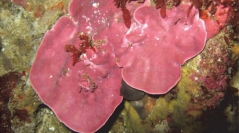

 Cryptogamie, Algologie
42 (11) - Pages 153-172
Cryptogamie, Algologie
42 (11) - Pages 153-172Lithophyllum stictiforme (Areschoug) Hauck contributes to the formation of the Mediterranean coralligenous concretions. In the Atlantic Iberian Peninsula, L. stictiforme has also been reported based on subtidal collections showing the characteristic morphology described for this species. Recent studies uncovered a diverse complex of cryptic species from the Mediterranean Sea assigned to L. stictiforme. Thereafter, the Atlantic Iberian collections have been re-assessed with the aim of clarifying its taxonomic status. Based on molecular (COI, psbA) and morphological data, the new species Lithophyllum artabricum V.Peña, sp. nov. is described herein. Molecular phylogenetic analyses were congruent in delimiting the Atlantic Iberian collections as an independent lineage from the Mediterranean L. stictiforme complex. Morpho-anatomical characters of the new species showed an overlap with those provided for the Mediterranean clades of L. stictiforme. However, L. artabricum V.Peña, sp. nov. has a monomerous thallus construction whereas the Mediterranean taxa were mainly dimerous. Moreover, L. artabricum V.Peña, sp. nov. differs from other Atlantic European Lithophyllum species by a combination of characters related to the external morphology consisting of single or superimposed lamellae, the monomerous construction, the conical shape of the canal pore of sporangial conceptacles, and by occurring only in subtidal bedrocks. Lithophyllum artabricum V.Peña, sp. nov. is at present known from northern Spain to northern Portugal. One collection of L. stictiforme from southern Portugal showed similarities with L. artabricum V.Peña, sp. nov.; however, DNA sequence data are necessary to confirm this record. Based on the evidence presented herein, L. stictiforme is removed from the flora of northern and northwestern Spain, and northern Portugal. The finding of cryptic diversity in L. stictiforme suggested that further reports of this species in warm and temperate waters should be re-assessed.
Crustose coralline algae, DNA barcoding, Lithophyllum frondosum, Lithophyllum grandiusculum, Mediterranean, morpho-anatomy, NE Atlantic, new species